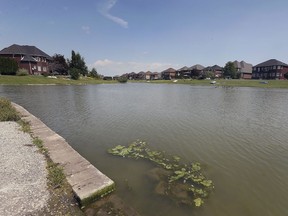Toxic water warning issued for Windsor neighbourhood

Article content
Residents living in Southwood Lakes, filled with executive homes and luxury townhouses, are being urged not to get too close to the man-made ponds that help make the South Windsor neighbourhood so attractive.
And they’re also being asked to go easy on their use of lawn fertilizer.
Blue-green algae, naturally occurring but potentially dangerous to human and animal health, has been detected in three of the subdivision’s four ponds designed for stormwater retention following downpours.
Blue-green algae (also known as cyanobacteria) are microscopic organisms that occur naturally in freshwater lakes, ponds, rivers and streams. In warm weather, with the right mix of nutrients (phosphorous and nitrogen), they can form into large masses called blooms which can contain toxins.
Such blooms have increasingly become a summertime environmental menace in Lake Erie — both in size and frequency — with health experts pointing to the overuse of fertilizer chemicals on farms and lawns which are then carried away in stormwater runoff.
“Pets and young children are particularly vulnerable to the effects of blue-green algae and should not be permitted to play in or near the water,” the city’s public works department said in a statement.

The ponds at Southwood Lakes, located east of Howard Avenue and north of Highway 401, are part of the city’s stormwater management infrastructure and not meant for recreational use, and there is on-site signage to that effect. Adjacent property owners were notified by mail of the blue-green algae discovery.
“We advise against recreational use, but it’s common for people to be down by the water,” Dwayne Dawson, the city’s executive director of operations, told the Star.
Due to COVID-19, more people are spending time at home, the city’s outdoor pools remain closed and municipal playgrounds only began reopening to children on Wednesday after a five-month closure.
Fertilizer for lawn and garden maintenance, applied by either professional companies or property owners themselves, is likely leading to higher levels of phosphorous getting into the ponds. This summer has seen hot weather and the blue-green algae can thrive in shallow, stagnant water.
Because they’re used for stormwater management during rainstorms, it’s not just runoff from the adjoining properties that can affect nutrient loading. Dawson said any water that runs into the storm drainage system through roadside catch basins in the neighbourhood also ends up in the ponds.
“It’s a combination of people fertilizing and watering lawns and, over an extended period, a lot of heat and not a lot of rain,” said city engineer Mark Winterton.
The University of Windsor’s Great Lakes Institute for Environmental Research confirmed the presence of cyanobacteria, and the Windsor-Essex County Health Unit has been consulted. Meanwhile, Winterton said the city also continues to monitor the situation. Cooler weather or a big rainfall, which would also lead to cooler water in the shallow retention ponds, will help clear the water.
While property owners love green lawns, Winterton said those whose lands abut stormwater management ponds should consider “more organic measures, or be much more judicious in applying (fertilizer).”
The Southwood Lakes “storm retention facilities” are older — designed in the 1980s — with “hard-edge” perimeters and lacking the types of vegetation of newer ponds, like those in east Windsor, built for the same purpose but which are much more resilient against blue-green algae.
For more information on cyanobacteria, which can make water appear bluish-green, search for blue-green algae on the Windsor-Essex County Health Unit’s website.









Postmedia is committed to maintaining a lively but civil forum for discussion. Please keep comments relevant and respectful. Comments may take up to an hour to appear on the site. You will receive an email if there is a reply to your comment, an update to a thread you follow or if a user you follow comments. Visit our Community Guidelines for more information.